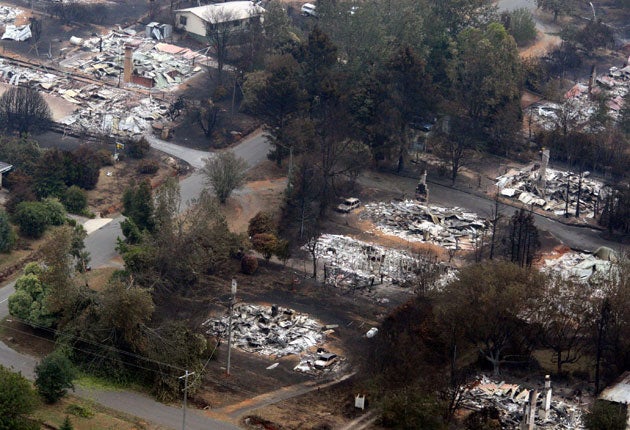After the fires: Australia's gardens of death
Police fear another 100 bodies may yet be found in the small town of Marysville – and suspect an arsonist is to blame

From the air, it looks as if someone has taken a giant demolition ball and swung it at each and every house in the small town of Marysville; until you notice the charred trees and blackened earth. Up to 100 people may have been killed,one in five of the population, when bushfires swept through the small town in Victoria which residents used to call "God's own garden".
The town has been sealed off all week and survivors have been barred from returning to check their ruined homes because so many bodies have yet to be recovered. One resident, Ian Pearson, was in the town until Tuesday, sheltering for two days in one of a handful of houses still standing. "I've seen the inside of hell," he told Melbourne's The Age newspaper. "If you've seen pictures of Hiroshima, that's what it's like."
The Victoria state Premier, John Brum, has said the town would remain off limits, because of the ghastly scenes there. "There are still many deceased people in homes," Mr Brumby said. "If people return to those areas... the impact [on them] would be quite devastating." He said there were possibly 50 to 100 deaths in Marysville.
For residents around the "ground zero" of the Victoria bushfires, there was anger and there was despair yesterday. Despair at the devastation inflicted on their quiet, pretty hamlets; anger at the nameless individuals they believed responsible.
Since bushfires roared through the area last Saturday, killing at least 181 people, forensic teams have been raking through the wreckage. They face a formidable task: establishing whether the six separate fires that destroyed 850 square miles of land north-east of Melbourne were deliberately lit.
The Assistant Commissioner of Victoria Police, Dannye Moloney, said a major blaze in the Gippsland area, near the town of Churchill, was being treated as suspicious. And the fire that wiped out Marysville may have been started by arsonists too.
Mr Moloney heads a taskforce of 25 officers who have been scouring the sprawling disaster zone for clues for four days. In that ruined landscape, where blackened trees rise out of a sea of rubble and corrugated iron, they were unlikely to find a discarded match or bottle of accelerant. But, the police chief said, arsonists "always leave something behind, whether footprints or fingerprints or DNA".
Equally important, perhaps more so, is information, and police have appealed to locals to report anything unusual or suspicious they saw, such as an unfamiliar car. They are investigating whether anyone in the area has a history of arson, or had a motive for setting the bush ablaze last weekend. But rumours of an imminent arrest are unfounded, officials warned.
Up to half of Australia's wildfires are deliberately lit, according to the Institute of Criminology. Darren Muller, a bushfire crime analyst, said the typical arsonist was a young man, often a loner, from a low socio-economic background, with a record of violence, and driven by a thirst for excitement or recognition. "Lighting a fire fulfils some psychological need for them," Mr Muller said.
In Kinglake, where at least 39 people died, survivors learnt last night that police had ruled out arson in their area. The news triggered mixed emotions, relief that the deadly inferno was not caused by human hand, and bewilderment. For if firebugs were not to blame, who was?
Ascending the winding road to Kinglake, in the Upper Yarra Valley, the scale of the devastation becomes sickeningly clearer. On both sides, a desolate, black landscape extends as far as the eye can see. Burnt-out cars, many of them death traps for families who tried to flee the flames, are dotted along the roadside. Cows huddle in a small patch of yellow grass in the middle of a charred paddock. A dead horse lies on its side, like a macabre statue.
The entrance to the town is marked by an illegible road sign, the white lettering melted. Fallen trees are still smoking. Nearly every house is flattened, with often just a chimney remaining. Molten shreds hang off a forlorn-looking children's trampoline.
So many people died here, the grief in the air is palpable. Compounding that grief is the knowledge that certain victims have yet to be identified. The heat was so intense that some bodies were reduced to ashes. An air exclusion zone is in force over Kinglake, to prevent aircraft "blowing away the DNA", as one policewoman puts it. Premier Brumby has warned that, overall, 50 victims may never be identified.
Mick Gaskin has lost his home and nearly everything he owns, yet he feels "as if I've won the lottery", because his family survived. He and his wife, Trisha, travelling in separate cars, each accompanied by one son, had to drive through a 100-yard-deep wall of fire. "I couldn't see anything," he said. "All I could do was hold the steering wheel straight. All around us was red flames. You couldn't touch the windscreen. I kept apologising to my son, saying 'Sorry, mate'. I thought I'd killed him."
Earlier that day, 14-year-old Trent and Brent, who is eight, had been splashing around in their free-standing swimming pool, a Christmas present from their parents. The pool, full of filthy water and debris, is almost intact. Mr Gaskin left his wedding ring by his bed on Friday night. Yesterday, he poked around in the pile of rubble that was his bedroom. "I don't like my chances of finding it," he said, with a sigh.
Subscribe to Independent Premium to bookmark this article
Want to bookmark your favourite articles and stories to read or reference later? Start your Independent Premium subscription today.

Join our commenting forum
Join thought-provoking conversations, follow other Independent readers and see their replies